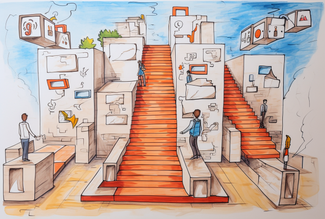
The growing burnout problem, and why we need to talk about it
It's two in the morning. You lie awake, watching the digits on your alarm clock crawl forward. You know you need to get a good night’s sleep for work, you have a brainstorming meeting tomorrow morning and haven’t been performing to your usual standards. Maybe you feel disjointed between all your projects and can’t seem to get your head around what to do about it.
Employee burnout is experienced in a multitude of ways. Most describe it as an extreme form of work-related stress. But the most damaging factor of burnout is that it doesn’t just affect your mindset during work hours, and can lead to employees feeling less satisfied with their jobs.
For employees, burnout has become part of the common lexicon. For employers, managing burnout has become vital to retaining team members and maintaining a healthy, productive workforce. But how does productivity and organization factor into burnout — and what can be done to solve it?
What is burnout?
Burnout doesn’t just result in decreased levels of productivity — it can also cause depression, anxiety, insomnia, exhaustion, and an increased amount of disillusionment with your job. According to the World Health Organization, burnout is a syndrome that results from mismanaged, chronic stress in the workplace.
77% of professionals have experienced burnout at their current jobs. And even individuals who love their jobs aren’t immune to stresses that can add up over time. Burnout isn’t just a business-world buzzword, it’s a condition that has seemed to worsen as more companies switch to a remote or hybrid model.
Burnout is a workplace problem. It results from miscommunication, imbalance, and a lack of structure. For a lot of us, those issues may have been present working in an office but became overwhelming once we moved to remote work in 2020.
The connection between WFH and employee burnout
When my own case of burnout reached its peak early on in the Coronavirus pandemic, I tried to find out if others were feeling the same.
And they were. 57% of respondents to a recent survey investigating the culture of overwork in Big Tech companies said they were currently experiencing burnout. But a more concerning Stanford study pointed to the fact that companies who moved to a work-from-home model were experiencing two different communication realities: Nearly 100% of bosses described themselves as supportive and barely half of their workers agreed.
The truth of the matter is, working from home has erased the divide between “work” and “life.” I go to bed, wake up, and work all in the same room. Researchers have proven that this lack of separation makes it harder for remote workers than traditional workers to switch off at the end of the day.
Prior to COVID-19, some of the top reasons for employee burnout were:
- unmanageable workload
- unclear communication
- lack of support
- unreasonable time pressure
Looking at this list, it’s easy to see how these factors could spiral out of control when working remotely. Odds are, if a team has an unmanageable workload and unclear communication, those issues are going to become a lot harder to ignore under a remote or hybrid working model.
A lot of our current tools for working productively have fueled these challenges by lacking connectivity and an effective avenue for communication.
Workplace apps have become an added stress
Productivity apps haven’t so much helped us focus on getting more work done as they’ve made it nearly impossible to ever escape the constant stream of notifications, tasks, emails, alerts, meetings, rescheduled meetings, last-minute meetings, small meetings, group meetings, team meetings — the list goes on.
According to Jerome Fried, co-founder of Basecamp, instant messaging has created a culture of “instant responding,” by virtue of which we no longer feel like we can let a message go unanswered for even a minute.
Ironically, the prevalence of productivity apps — combined with the added stress of WFH and the brand-new state of panic brought on by the global COVID-19 pandemic — might actually be part of the reason so many of us are having a hard time being as productive as we’d like to be.
So, where does this leave you?
Moving forward, one step at a time
If you’ve been going through burnout, knowingly or unknowingly, you’ll probably be ready to try just about anything to make life a little less stressful and to bring a little joy back into your professional endeavors.
Of course, it goes without saying that everybody’s different, and we all cope with stress in our own ways; but that’s not to say we can’t turn to science for a bit of a helping hand, and that’s exactly what I did when things got really bad.
Time and time again, mindfulness has proven to be an effective tool for managing stress, insomnia, depression, and the general feelings of lethargy and disaffection that comprise the core symptoms of burnout. Meditation-based apps are on the rise, making now the perfect time to dive into a Headspace or Calm, even if it’s just as a way to help you dissociate your phone from the panic evoked by that notification ding you’re all too familiar with by now.
With that being said, managing burnout is also up to leadership. Guiding employees through a crisis while sustaining culture is a difficult task, but performance and engagement depend on it.
A lot of the conversations about burnout frame it as an individual, employee issue. It’s not. Burnout rates were on the rise before the pandemic, and there are meaningful strategies a company can take to help reduce them.
Most of the direct causes of employee burnout come from prominent workplace issues that occur again and again.
Unmanageable workload, unclear communication, lack of support, and unreasonable time pressure are all things that can be managed by programming that comes from leadership, or by taking another look into the best ways your organization can communicate expectations.
Burnout is a systemic issue
Building a positive work culture in a distributed environment is just as important as building one in-person. A strong work culture encourages your employees to be honest with how they’re feeling and the struggles they face on a daily basis.
Taking active steps like giving clear, actionable feedback without any ambiguity and encouraging your team members for their small wins are two fairly simple steps you can take to help employees and co-workers feel more supported. Presenting your team’s big-picture vision and overall goals can also help them contextualize their work, making it feel less demanding.
Burnout is complex. And the truth of the matter is while solutions like meditation, time-management, and more sleep can be helpful, flooding the conversion with self-help techniques continues to place the issue on the backs of employees. Take a look at your workplace environment and industry shifts for a more lasting and impactful answer.



